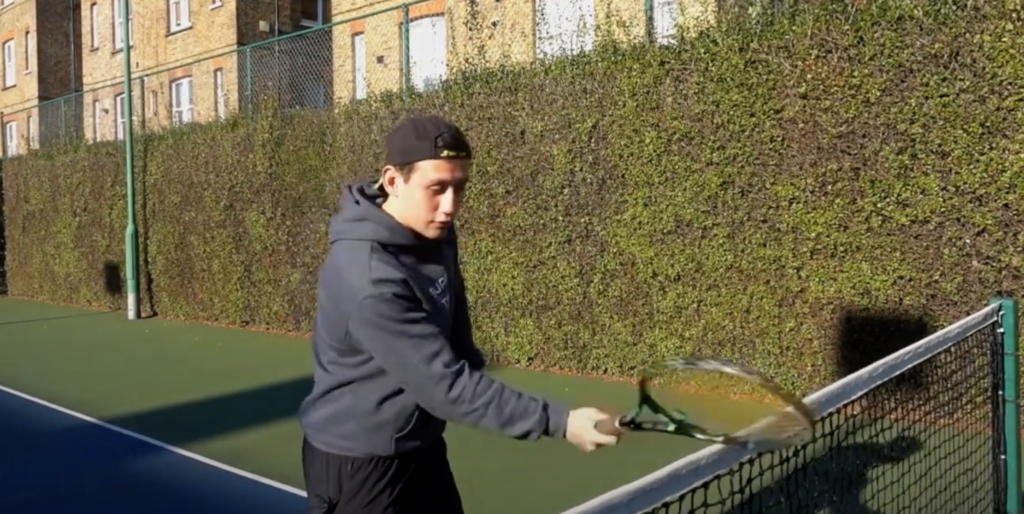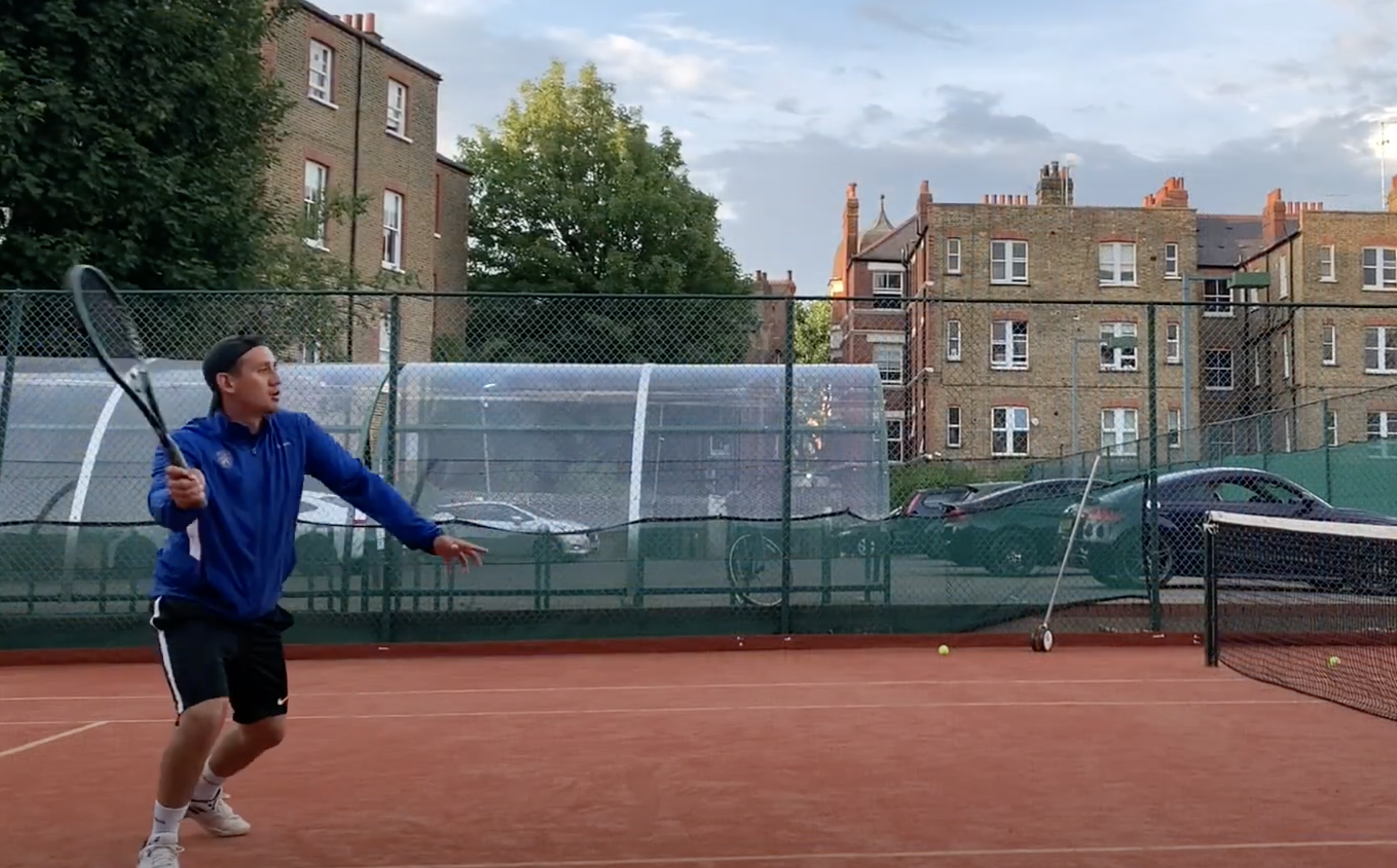Today, we’re diving into an in depth tutorial on mastering the art of volleys in tennis. These shots play a pivotal role in closing out points, altering rally dynamics, and introducing a valuable element of versatility to your overall game. Not to mention, the significance of volleying is particularly crucial in doubles.
In this tutorial, Leon will guide us through several key points, each with the potential for an immediate positive impact on your net game. So, let’s explore this tutorial together, breaking down and discussing each point thoroughly to enhance your understanding of how to execute the perfect volley on the tennis court.
Tip 1
Let’s delve into our first key tip focusing on the racket path during your volleys. A prevalent mistake to watch out for is the tendency to “hack” down on the ball, often in an attempt to generate backspin.

Rather than exaggerating a downward swing through contact, envision yourself carving through the ball and levelling out the swing. Envision following the path indicated by the green arrows, and not the red arrow indicated in the video. This adjustment not only contributes to a cleaner technique but also helps in achieving the desired backspin without compromising the overall efficiency of your volley.
Practise drill
Here’s a fantastic drill to reinforce the correct volley path: make use of the net itself. Position yourself alongside the net, racket in hand, and perform shadow swings above the net, gently skimming the tape. This drill is particularly effective because the net serves as a tangible obstacle, discouraging any tendency to chop down on the ball.

By practicing this motion, you’ll develop a more refined feel for the desired racket path without the risk of falling into the common mistake of a downward swing. The net becomes your guide, ensuring that your volleys maintain the necessary level trajectory. Give this drill a try to enhance your muscle memory and fine tune your volley technique. It’s a practical and constructive way to ingrain the correct motion into your volley shape.
Tip 2
This next one is a game changing tip for your volley game – Tip Number Two. This one involves a shift in your grip dynamics, and it’s going to have an immediate impact if you are not doing it already. Unlike most other shots in tennis, where a loose grip is generally preferred, when it comes to volleys, we’re flipping the script.

Just before contact, remember to give your grip a subtle squeeze. This might seem counterintuitive, but it serves a crucial purpose. By maintaining a firmer grip at the point of contact, you maintain the pace of the incoming ball. This is key in maintaining control and precision in your volleys. Conversely, loosening the grip in this scenario could absorb the ball’s pace, leading to the opposite effect. While a looser grip has its merits in certain situations, like drop volleys, maintaining a firm grip at contact is a key element to keep in mind for consistent, deep volleying. Give it a try during your practice sessions and notice the immediate impact in your overall game.
Tip 3
Let’s delve into Tip Number Three, a crucial aspect that involves leveraging the power of your lower body to get more power on your volleys. This tip focuses on the use of your legs to generate more force behind the shot.
The key here is to load on your outside foot, treating it as your anchor point. As you position yourself, use this foot to channel all your momentum through the ball. The pivotal moment comes as you transition to your other foot, pushing through and transferring all that stored energy to your volley. This principle applies to both forehand and backhand volleys, with the only difference being the use of opposite feet.

So, to maximise power on your volleys, remember this: load and push. By integrating this technique into your game, you’ll find yourself harnessing extra force, adding a dynamic element to your volleys that can make a significant difference in your net game.
Tip 4
Now, let’s explore Tip Number Four, a subtle yet impactful adjustment to your volley technique. This tip revolves around introducing a slight tilt of the racket head during your takeback position.
Take a minute to observe professional tennis players on YouTube, and you’ll notice a commonality among them – a slight tilt of the racket head before they punch forwards on their volleys. This technique adds a bit more pop to the shot and, prevents the tendency to slap down on the ball.

However, it’s crucial to strike the right balance. While tilting the racket head, avoid fully opening the strings to face the sky. Instead, aim for a sweet spot around a 45 degree angle. This position optimises the racket’s orientation for effective volleying. So, take a cue from the pros, incorporate this tilt into your takeback, and feel the enhanced control and power in your volleys. It’s a small adjustment that can make a significant difference in refining your overall volley technique.
Tip 5
Let’s wrap up with our final tip, a piece of advice that might raise an eyebrow initially – the idea of incorporating a swing into your volleys. Now, you might be wondering why we’re suggesting this when the general consensus leans towards a more compact, block or punch approach to your volleys.
The idea behind this tipis to capitalise on opportunities. If the ball is right there, ready to be hit, well, why not hit it? While it’s true that maintaining a compact form is essential for the majority of volleys, there are situations where a bit of a swing is not only acceptable but can be hugely advantageous.

It’s crucial to assess the characteristics of the incoming ball. If it’s sitting up, moving relatively slow, and lacks aggression, that’s the perfect moment to unleash a more expressive swing. While some coaches may emphasise that strict block or punch through technique, it’s worth noting that even the pros inject a bit of a swing when the situation calls for it.
So adapt your volley approach based on the specific characteristics of the ball. If it’s there to be put away, a controlled yet slightly more expansive swing can be a strategic move. So, consider the context, trust your judgment, and embrace the versatility of your volley game.
Summary
So just a quick recap… this guide offers five key tips to enhance your volley technique. Tip one emphasises a clean racket path to avoid common mistakes, with a practice drill using the net to reinforce the correct trajectory. Tip two suggests a subtle grip adjustment for volleys, promoting a firmer grip just before contact to maintain ball pace and improve control. Tip three focuses on leveraging the lower body for increased power, emphasising loading on the outside foot and transferring momentum. Tip four introduces a slight tilt of the racket head during the takeback for added pop and control. Finally, tip five challenges the compact form norm, suggesting a bit more of a ‘swing’ when the situation allows for it, adapting to the ball’s characteristics. Overall, these tips offer a great approach, guaranteed to elevate your tennis volley game.

